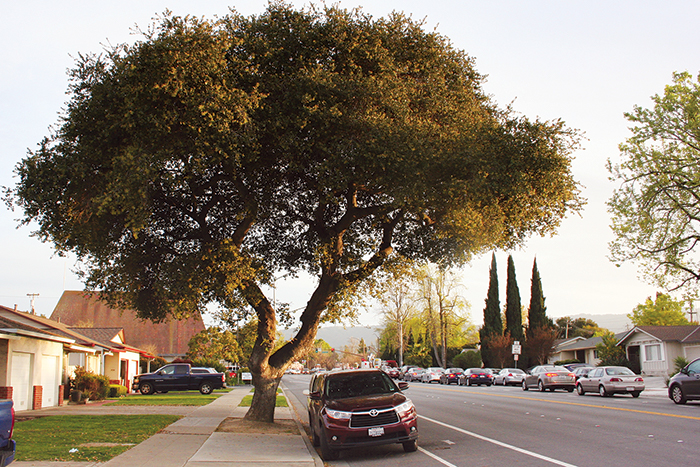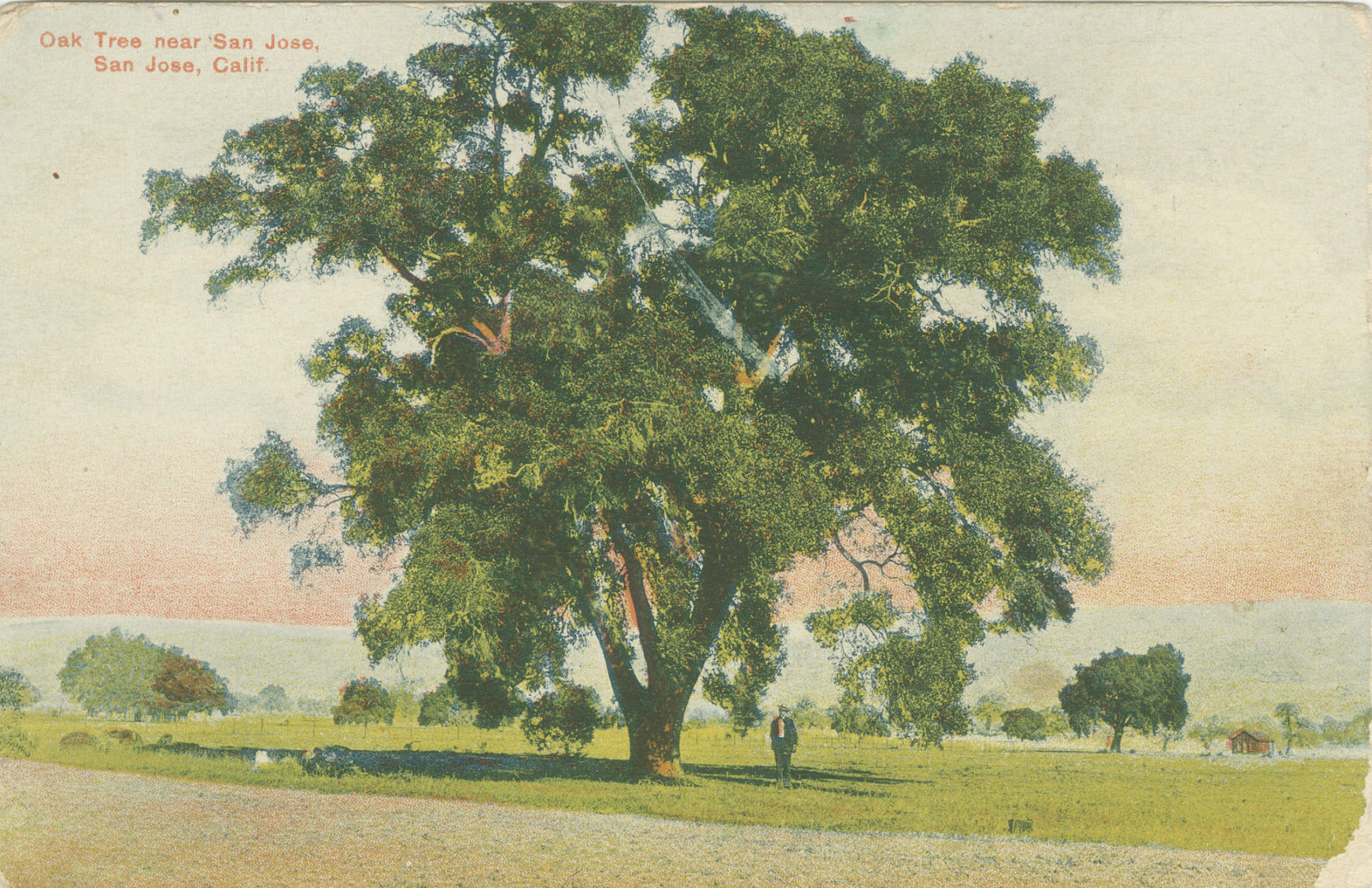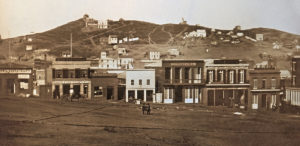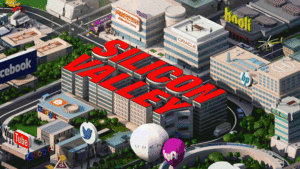This is an excerpt from a longer essay first published in December 2017.
Three hundred years ago, to walk from the site of the modern-day Apple Campus in Cupertino to the bayshore site of the modern-day Google headquarters in Mountain View would take about four hours. You would start in an oak savanna at Calabazas Creek on the west edge of Tamien Ohlone tribal lands, walk west through oak woodland and chaparral to Stevens Creek, then turn north to follow the waterway through oak woodland and oak savanna, until the water fanned out into willow woodlands and the lazy water of the south Bay near the Ramaytush Ohlone village of Puichon.
On the walk, and in the entire Silicon Valley, you would have encountered fewer than 20 species of trees. Lord among them would have been the oak. As recently as 1850, according to a new report from the San Francisco Estuary Institute (SFEI), 80 percent of the trees in Palo Alto, Mountain View, and Cupertino were oak trees. Another 13 percent of the trees were those commonly found alongside oak trees in oak woodlands: buckeye, madrone, sycamore, and California bay laurel. Willows, alders, and redwoods rounded out the final 7 percent.
Oaks defined the place. Postcards from San Jose in the early 1900s show farmers standing in the shade of skyscraping oak trees. Spanish explorers called Silicon Valley the “plain of oaks.” The Peninsula is still home to at least two Roblar Avenues, a Robles Drive, and a Robles Park, as well as the North Fair Oaks neighborhood of Sunnyvale and the Menlo Oaks neighborhood of Menlo Park.
Most of Silicon Valley’s oak trees were valley oaks, the largest and longest-lived of North American oak trees and endemic to California. They grew tall and towering, and “in such numbers,” a one-time gold miner named Thaddeus Kenderdine wrote in 1898, “that I wondered the farmers tolerated them.”
The farmers, of course, did not tolerate them. Valley oaks thrive in the rich soil of creek floodplains, which happens to be prime agricultural land. The farmers cut the oak trees down and replaced them with fruit orchards. Later developers paved over the orchards and cut down what oaks remained to build sprawling residential neighborhoods. Over 150 years, scientists at SFEI estimate, there has been a 99 percent decline in valley oak populations in some parts of Silicon Valley. People wonder sometimes why Silicon Valley seems to have no sense of place; one answer is that people understand a place by its nature, and Silicon Valley is missing its iconic trees.
Recently I walked over the buried oak woodlands from the new Apple Campus in Cupertino to the Googleplex in Mountain View. On the default view of Google Maps there are only three green areas on this entire 10-mile route: two school baseball fields and a playground. There are no valley oaks at all. As I walked I tallied coast live oaks in the neighborhoods and kept it to a single sheet of paper. But once I was looking it was also easy to see the surprising biodiversity on display in this gray, flat, sprawling corner of the world. There are trees everywhere. There are trees by the thousands. In place of lost valley oaks we have invited in an absolutely staggering increase in tree diversity.
Today there are something like 400 species of trees in Silicon Valley. Oak trees, mostly coast live oak, make up about 4 percent of the total. London plane, magnolia, and sweetgum make up about 8 percent each. This is a reasonably consistent list of common street trees in most cities in North America. The London plane, for example, a hybrid that first appeared in Europe, is also the most common tree in London and New York, and an extremely common street tree in Buenos Aires, Rome, Paris, and San Francisco. The more influence human landscape choices have on the world, the more our nature is becoming the same no matter where you are—a term urban ecologists refer to as ecological homogenization.
Yet while the trees themselves have changed, the percentage of canopy itself hasn’t changed particularly between the 1850s and today. What SFEI’s Robin Grossinger and Erica Spotswood point out is that many of the trees in that canopy are aging. Many were planted more than 50 years ago in post–World War II suburban developments, and many will soon need to be replaced. Imagine the potential, Grossinger and Spotswood say, if we started thinking about how to replace them, tree by tree, to make the best use of that canopy across the entire valley.
“This is an area of literally hundreds of thousands of acres around the Bay, and probably a million or more trees,” says Grossinger, a historical ecologist and co-author of the report Re-Oaking Silicon Valley: Building Vibrant Cities with Nature. “In the Bay Area we’ve done a pretty remarkable job protecting the hills and the Bay and the baylands, of protecting and preserving a greenbelt and a bluebelt. But we’ve tended to ignore the gray area in between, just leaving it to be a blank from a conservation perspective.”

A coast live oak sequesters more carbon than many other common urban trees—even a redwood—and twice as much as Silicon Valley’s most common street tree the London plane, according to data from the Center for Urban Forest Research Tree Carbon Calculator. Oaks tolerate drought yet draw up more runoff than many other trees in heavy rain. Oaks host California wildlife. In the re-oaking report Spotswood paid close attention to the benefits of oak trees to acorn woodpeckers, oak titmice, and mournful duskywing and California sister butterflies. Finally, oaks are historic. “Restoring elements of oak woodland ecosystems to urban environments could make California cities less similar to cities in other parts of the world,” the report says, “reinforcing a distinctive identity and adding character that could complement local landscapes and architecture.”
The challenge seems to be getting Silicon Valley to want to add that character. Grossinger and the SFEI team have been studying oak trees in Silicon Valley for a decade. But it took the more recent interest of Google to kick-start a re-oaking project.
As Google’s real estate holdings increased, its ecology team went in search of scientifically sound landscaping options for its green campuses. They found SFEI and asked Grossinger for technical guidance. The result was Re-Oaking Silicon Valley. “We’re not going to create oak savannas,” says Google Ecology program manager Audrey Davenport. (Disclosure: Google also sponsors Bay Nature’s annual fund raising event.)“But we actually can bring the function of an oak ecosystem back to these places. We can help wildlife. The re-oaking guidance has been great because I can turn to landscape architects and say, ‘Here’s what we want to see in your designs,’ and they can work with that.”
Google has incorporated re-oaking into the designs for two of its new campuses and converted 50 acres of its existing campuses to native landscaping. On the other side of the valley Apple has landscaped its new campus with thousands of oak trees. My cross-valley walk started and ended in ambitious, heritage-honoring oak landscaping. But a successful re-oaking of Silicon Valley hinges on what happens in between the two tech giants, in the great gray suburbs where new trees are chosen one property owner at a time. Will the tech companies influence their residential neighbors—schools, suburban developers, office parks, homeowners—to choose oak trees instead of cheaper, more popular London planes, sweetgums, or magnolias?
Ecologists I’ve talked to have generally described this re-oaking experiment as pioneering. There are lots of urban greening initiatives out there—stormwater runoff programs, backyard pollinator gardens, low-impact building materials—but no one has tried to bring back an ecosystem by connecting the dots, yard-to-yard, in an urban region the size of Silicon Valley. It’s a reminder, many of them told me, of how far we’ve come in appreciating the value of urban conservation.
Twenty years ago scientists viewed urban ecology as a great unknown. Or less than that, as futile. But University of Washington urban ecologist Marina Alberti says it’s increasingly apparent that nature in the city is the best way we have to reconnect people to the world around them. “Humans are a dominant species on this planet,” Alberti says. “They’re going to determine in many ways the future of the planet. Whether they will be able to actually help—to evolve the planet in a direction that is mutually beneficial for our species and other species—really depends on whether we understand the power we have.”




-300x200.jpg)
.jpg)